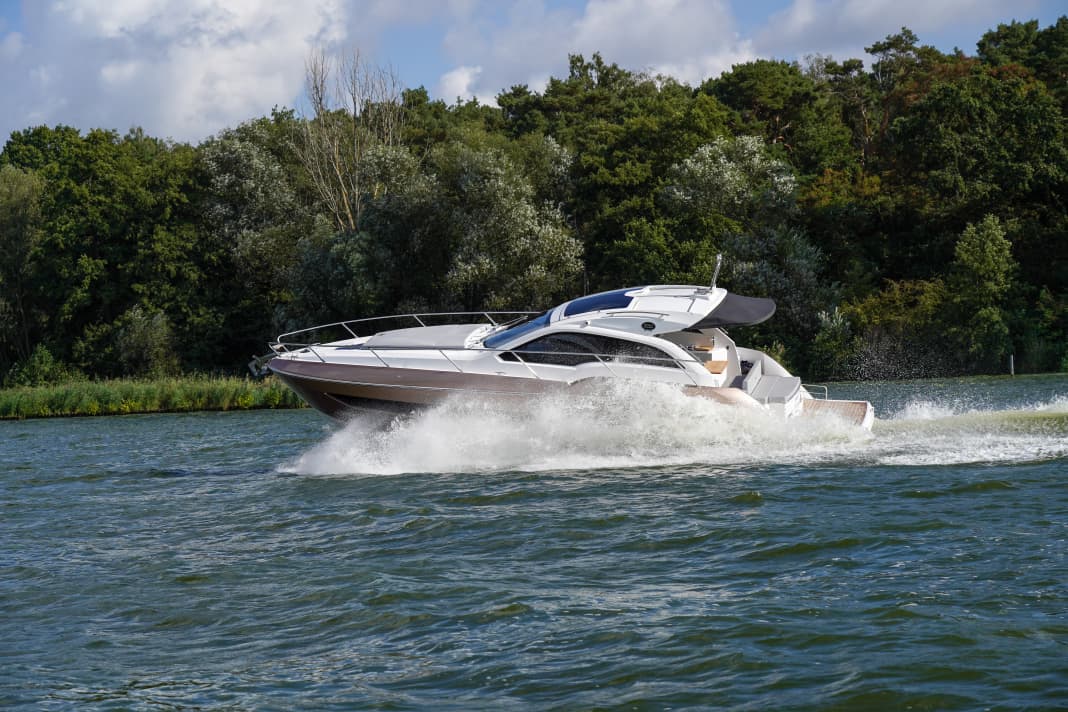





We enter the boat from the stern via the large bathing platform and immediately notice that there is plenty of space to sit or lie down. When we measure it later, we realise that the impression is not misleading. Without the back cushion that separates the aft seating area from the cockpit table, the boat has a sunbathing area of 1.65 x 2.50 metres.
The cockpit table, which seats six people comfortably, is made of teak and is well made. The quality of the seat cushions is also good: they are pleasantly firm. We continue with the small cockpit lounger on the port side. It measures 2.35 x 0.94 metres and is ergonomically shaped. If you open the tinted glass roof, you can also work on your personal tan here. On the starboard side there is a small galley with a two-burner gas hob, a sink with hot and cold water and an Isotherm refrigerator. This alone would be a little small, but there is another one below deck. There is also plenty of storage space.
The engine data is displayed via a Volvo glass cockpit at the helm. Navigation data and everything else you want to see can be viewed on the Raymarine plotter. Various toggle switches, the controls for the anchor winch and the bow thruster are also easily accessible. All in all, the layout is clearly organised. Forward visibility through the safety glass is good. The driver's seat is designed as a sports seat and offers lateral support.
This is what it looks like below deck on the Sessa
Below deck there is a small L-shaped seating area and the second, slightly larger galley. The aforementioned second refrigerator is also located here. The saloon table can be lowered and the sofa becomes another small bed. This is too small for adults, but perfectly adequate for the children's afternoon nap. The cabins lead off from here. In the bow is the owner's cabin with a 1.50 x 1.95 metre bed. There is sufficient storage space in two cupboards. The feeling of space is pleasant. When lying down, you can look out of the side hull windows and the deck hatch provides even more light. The ceiling panelling is made of fabric and the sides are partly covered with wood veneer.
The underfloor cabin in the rear also has a 1.50 x 1.95 metre bed and a hull window. As far as the feeling of space is concerned, however, you have to make concessions compared to the bow. Nevertheless, you don't feel like the ceiling is falling on your head when lying down. The fabric upholstery gives the room a pleasant and cosy feel.
Of course, a boat in the 11-metre class must also have a toilet. This is located between the two cabins and is equipped with a washbasin and toilet. The latter is covered by a plastic flap that serves as a seat when showering. Ventilation is provided by an opening hull window. There is plenty of storage space and also enough room to dry off after showering.
The Sessa C3X is available in three different versions. An open version without a roof, a T-top version and one like our test boat with a hard top. You can also choose between an inboard and outboard engine. We drove the inboard version with two V6 petrol engines from Volvo Penta. If that's not enough, the boat is also available with two 350 hp engines.
Test drive values
The combined 450 hp of our two V6s accelerated our test boat to a maximum of 40 knots. That's pretty good for a boat of this size. Thanks to the deep V-hull, the boat is very manoeuvrable on the slalom course and likes to lean to one side. This may feel unfamiliar to inexperienced sailors at first, but it is not a problem and is safe at all times, even at high speeds. The lean angle can be utilised for particularly tight turns.
Even at lower speeds (between 3 and 8 knots), the handling is good. The Sessa sails straight ahead in a stable manner without lurching. The transition to planing takes place at around 10 knots, at around 22 knots (around 4000 revolutions per minute) the boat runs optimally. The boat is economical at 4000 rpm and 22 knots. If you put the lever on the table, the log displays 40 knots. The boat then consumes 197 litres per hour.
By the way: If you don't like gold, the C3X is of course also available in other colours.
Technical data
- Length: 11,33 m
- Width: 3,45 m
- Depth: 1 m
- Weight with motor: 6,5 t
- Fuel tank: 750 l
- Water tank: 286 l
- Black water tank: 110 l
- Freeboard:1,45 m

